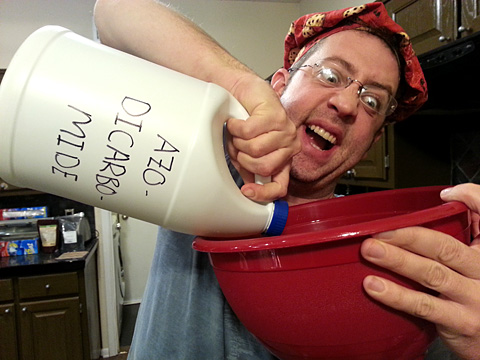
This week, news has spread across the media about Subway’s use of the chemical azodicarbonamide (EH-zo-die-car-BAHN-ah-mide) in their breads. The blogger Vani Hari, who owns the popular website FoodBabe, has been after Subway for several years for using this commercial dough conditioner, which is also used in making foamed plastics, like yoga mats and shoe soles. Hari has been blogging about it, making videos of herself eating her yoga mat, and publicly calling on Subway to remove this chemical for several years, but yesterday her pleas went viral, and today she appeared on every media outlet imaginable, promoting her petition to have Subway stop using the chemical, and prompting Subway to state that it will remove azodicarbonamide from their breads “soon.”
Subway isn’t the only company using this chemical in their breads. Many, many commercial breads on your supermarket shelves also contain the chemical. Some sources report that Panera uses it in their much-hyped old world style breads, though they don’t publish their ingredients on their website, like Subway does, so that’s not confirmable. Even brands that tout their breads as natural and wholesome, like Archer Farms, use the chemical in such breads as “Simply Balanced 100% Whole Wheat.” On a research trip to my local grocery store this afternoon, 7 out of the 11 brands represented on the bread shelf contained it.
What is this unpronounceable chemical, and why is it used in bread?
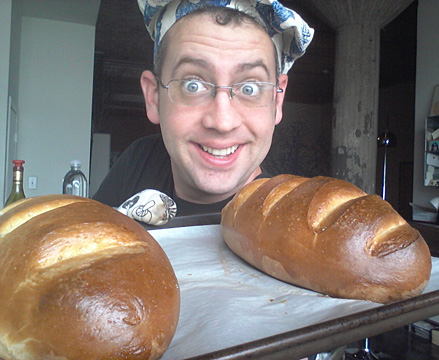
Azodicarbonamide is made by taking dihydrazine sulfate (which IS ingested by humans…it’s a blood pressure medication) and mixing it with urea, a compound that naturally exists in small quantities in the bodies of most animals that helps carry waste products out of the blood, and which is an important ingredient in fertilizers, explosives, and the production of plastics. They mix dihydrazine sulfate with urea and cook it in huge industrial pressure cookers. Then it is mixed with sodium chlorate, a chemical used to bleach paper and to kill weeds (but not in Europe, it’s illegal there because of its toxicity). Then azodicarbonamide is extracted from the resulting slurry. Hmmmm…sounds kinda like meth production, if you ask me.
This azodicarbonamide is used not only to produce plastics and synthetic leathers, it is also used in food. Naturally! Its primary use is to bleach flour. Why does your flour need bleaching? To make it more white, first of all, so that it looks nice. But that’s incidental. Freshly milled flour simply doesn’t make a good loaf of bread. Bread made with fresh flour tends to be slack, tough, and saggy. Bread flour needs to age. As it ages, it reacts with oxygen in the air and it…well…it oxidizes. This frees up groups of sulfur ions at the ends of chains of glutenin (one of the two natural compounds that react in wet flour to create gluten) so that they bond into gluten strands more strongly, resulting in a proud, high loaf. But naturally ageing flour takes a long time. And manufacturers can speed up this oxidation process by bleaching the flour, often with azodicarbonamide. This quickly, chemically oxidizes the flour, so it can immediately be shipped to consumers and result in a strong, happy loaf of bread. The alternative is unbleached flour, which is aged naturally until it oxidizes, and this explains why unbleached flour is more expensive than bleached flour…which always made about as much sense to me as why low-sodium chicken stock would cost more than regular sodium. There’s LESS sodium…so why is it more expensive? The answer for flour is that production costs are higher to age the flour naturally, because the process takes longer. A few cents worth of azodicarbonamide and the flour is ready to go immediately. I’m a staunch user of unbleached flours, but most pastry chefs won’t touch the stuff. It’s bleached or nothing for them, because it results in a superior product.
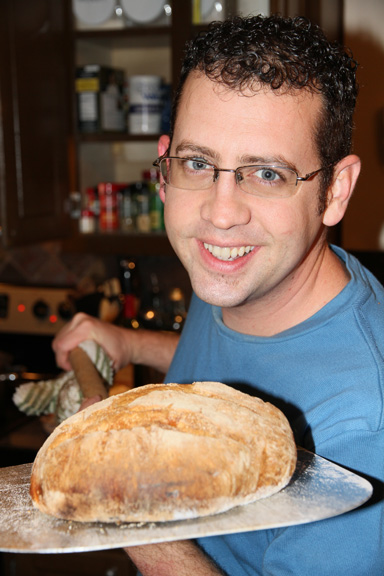
Azodicarbonamide’s second food use is as a “dough conditioner.” It reacts with wheat gluten to strengthen and develop it more quickly…a process that happens naturally with kneading and during the fermentation and rising process. But again…it’s a shortcut. And time is money. A commercial loaf of bread can go from dry ingredients to baked loaf in an hour or less. Because it doesn’t need to be kneaded or to rise. Because they add these chemical dough conditioners to manipulate the gluten so that the only rising process happens as it bakes. Azodicarbonamide produces a loaf of bread that is soft and fluffy. And somehow, back when the US lost track of what real bread looked and tasted like, and we started buying “sandwich loaf,” it was easy to accomplish a soft, fluffy white bread loaf. But then some of us wanted “healthy” whole grain breads. And it’s just not possible to naturally produce a loaf of whole grain bread that is soft and fluffy. That’s not what whole grain bread is. It’s earthy and nutty and pleasantly gritty and nourishing and sustaining…but it is NOT soft, nor fluffy. Yet we Americans loved our marshmallowy white sandwich bread, so, by God, whole wheat sandwich bread must be the same way. Enter azodicarbonamide. It allows manufacturers to deliver you an “all natural, wholesome whole grain sandwich loaf” that is light, airy, and fluffy. And completely against its nature.
Azodicarbonamide is not the only commercial dough conditioner. There are many others. DATEM is the one you’ll see most often, and it’s included in virtually every single bread on the supermarket shelf. They call it DATEM because it’s even harder to pronounce than azodicarbonamide. Diacetyl tartaric acid ester of mono- and diglycerides, thank you very much. Manufacturers don’t really know HOW DATEM improves bread dough, but it does. (Who was the first brave soul who opened a can of diacetyl tartaric acid ester of mono- and diglycerides and poured some into their bread dough?) DATEM comes from food grade glycerin and diacetyl tartaric acid. Even though many commercial food ingredients end in the word “acid,” most of them should give you no cause for fear. Tartaric acid is in your pantry, labeled “cream of tartar” and it’s an acid in grapes that falls out of solution during the winemaking process. Diacetyl is a naturally occurring organic compound that gives butter its flavor, and is also produced by several types of yeast, which explains why many Chardonnays taste buttery. It is also used as an artificial butter flavoring agent in microwave popcorn, butter flavored oils, etc. You may recall the scare a few years ago when many industrial workers who inhaled diacetyl regularly developed deadly scar tissue in their lungs.
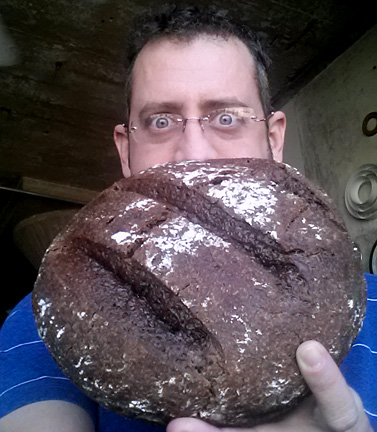
Other dough conditioners are fairly innocuous. Ascorbic acid is just vitamin C. Ammonium chloride is a common yeast nutrient in beer and wine making, it’s mixed in large amounts with licorice to make a popular candy called salmiakki in Scandinavia, and it’s also used in strong doses in expectorant medicines that you take when you have chest congestion. Potassium iodate, also a common dough conditioner and oxidizer, is the same substance used to add iodine, a nutrient crucial for the proper function of the thyroid gland, to table salt. (Though in our modern, varied diets, iodized salt is no longer necessary for most people,and iodized salt tastes TERRIBLE!) It is also used to prevent radiation sickness. There’s no need to be scared of it, it’s actually good for you.
But back to azodicarbonamide…the FDA and the USDA classify it as G.R.A.S., or Generally Recognized as Safe. (Though, merciful heavens, that name doesn’t sound the least bit comforting to me!) Canada also places this classification on it. In all other developed nations, it is banned or illegal. Because it is highly toxic. A truck carrying azodicarbonamide that overturned in Chicago in 2001 sparked the evacuation of high rise buildings, the rerouting of major traffic arteries, and first responders had to be hospitalized because of contact with the substance. Studies have found it can trigger asthma, skin reactions, and even proposed that, during the baking process, it breaks down into substances which are known carcinogens. But many of our food substances are poisonous in enough concentration or volume. A few Tablespoons of nutmeg will trigger hallucinations and miscarriage in pregnant women (who on earth could eat that much of it, though?!?) and enough of it will land you in the morgue. We all know the toxicity of alcohol. Raw green potatoes contain dangerous amounts of solanine, the same lethal toxin found in deadly nightshade. (Cooking deactivates the toxin.) Heck, even water will kill you if you drink too much of it.
The FDA insists that, during baking, azodicarbonamide fully decomposes into compounds that are harmless to humans. And they may be right, even if all other developed countries have banned its use as a food product. The compound is still present in its toxic form in many raw, bleached flours, however, which is why most bags of flour contain the warning to NOT consume raw flour or raw bread dough.
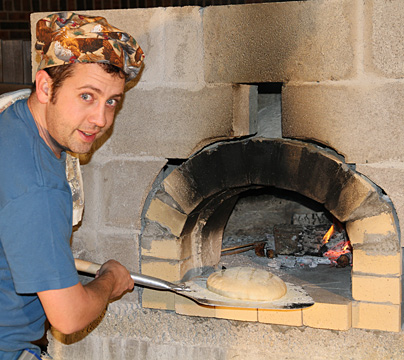
For me, all this is sort of ridiculous…because YOU DON’T NEED DOUGH CONDITIONERS TO MAKE PERFECT BREAD. You only need 3 ingredients…flour, water, and salt. And yeast, but that can come out of the air as easily as it can come out of a packet. Wild yeast breads (ie sourdough) are shelf stable for far longer than commercial breads packed full of preservatives. I have a loaf of sourdough pannetone that we baked for New Year’s Eve FRANK that’s still sitting on my countertop, two months later, without a speck of mold on it. I tasted some yesterday, and it tastes as good as the day I baked it. It’s not even stale. But industrial food manufacturers have never truly cared about making a quality product first and foremost. Their primary concern is PROFIT. And profit doesn’t come when it takes 2 days to make a loaf of bread. Profit comes when it takes 1 hour. So they’ll use whatever it takes to get the production time down to the shortest duration, because that maximizes profits. And that’s why you read a list of 30-40 ingredients in your bread from the supermarket…or from Subway…maybe even from your local “artisan” bakery…when all it takes to make the best bread in the world is flour, water, and salt. Industrial-scale factories could quite easily mass-produce sourdough bread with only those 3 ingredients that would be as shelf-stable or moreso than what they produce now. It would certainly taste better. But the process would take 2 days rather than 1 hour. They could certainly still churn out the same number of loaves each day given the right equipment. But it’s easier to pump in a little azodicarbonamide and diacetyl tartaric acid ester of mono- and diglycerides and get that loaf churned out in an hour.
Ultimately, who knows if azodicarbonamide in flour and bread has caused a single health problem in a single human? Perhaps just the opposite has happened, as it was recently discovered that azodicarbonamide inhibits retrovirus activity…meaning it shows promise as a treatment for HIV and other drug-resistant viruses…just as so many other poisonous substances can be used to treat or cure illness…or make delicious things for us to eat and drink, like the lovely bitterness that poisonous hops add to every mouthful of beer that everyone on the planet has ever drunk.

But why mess with something that thousands of years of history has taught us is already perfect? The miracle that happens when flour gets wet, and a little yeast ends up in it (whether from the air or an envelope), and some salt gets tossed in there for flavor…is such a perfect, simple, wondrous miracle. And baking bread is SO easy. Those of you who’ve never done it, or who did it with a terrible recipe ages ago and thought it was complex and took a long time…you’re laboring under a misconception. You can have a fresh-baked loaf of bread at home every single day of the week with only 5 minutes’ effort. And you don’t have to knead it. And your hands won’t get covered in dough. (Maybe a bit of flour to rinse off, but that’s all.) And it will cost less and taste infinitely better than anything you’ll find at the supermarket. Check out my Easy Overnight Old World Bread recipe, it literally involves stirring together 4 ingredients the first day…less than 5 minutes. Then 2 minutes of shaping into a loaf the next day, 1 minute to place a pot into the oven and to turn it on, 30 seconds to drop the loaf into the pot, and 30 seconds to pull it out and dump it onto a cooling rack. You spend as much time looking for the remote control and your keys or purse every day.
Commercially manufactured foods are chock full of things we can’t pronounce. Maybe some of them are responsible for our dramatic increase in cancer, Alzheimer’s, autism, ADHD…or maybe they’re all completely harmless. The answer probably lies somewhere in between the two extremes. But the points is that these chemical additives are not natural. They require complex chemical processes to create, and those who labor in factories to create them suffer because of it. Strangest of all…they aren’t NECESSARY. Enough effective natural preservatives exist to commercially manufacture and distribute any kind of frozen or processed food.
Ultimately, the only way to know what you’re eating, though, is to grow it and make it yourself. And we live in an era when our time is precious, and most of us don’t have the space or infrastructure to grow our own food, nor the time to cook 3 meals a day. What we CAN do is make better choices about what we feed ourselves and our families. And yes…that will come at a price. But what is more important in life? A nice house and an impressive car? 200 TV channels? A $4 Starbucks or energy drink twice a day? A night out at the movies? Name brand jeans or a designer purse or diamond earrings? Or enjoying delicious, healthy food, raised somewhere nearby by a man with a name and a family of his own who also eat what he grows out back, cooked in your kitchen with love and conscience, and served to people who mean the world to you?

Our nation is ripe for a healthy dose of reprioritization. Food is at the core of who we are, how we exist, and how we care for those we love. So it makes sense that food should be the start of this reprioritization. It’s a big, scary step, so don’t take it all at once. Maybe start by eliminating frozen microwave meals at lunch, and instead, toss together a quick salad. Or leave something yummy in the slow cooker that you can take instead. Try using Craigslist or localharvest.org to find local farms and take the family for a weekend outing. Patronize your local farmer’s market. Local co-ops and CSAs (community support agriculture) make it easy for busy professionals to support local farms and get the freshest local produce and meats, and many of them even deliver so you don’t even have to go to the grocery store. Carve a few dollars away from things in your life that truly don’t make you a better person, and put those dollars toward fresh, local food that will make you and your children strong and healthy, and will stay in your local economy to strengthen that, as well. You will never…EVER…regret it.
For more reading on America’s culture of processed food, check out Pandora’s Lunchbox by Melanie Warner. And please, please, please comment below!
Leave a Reply
You must be logged in to post a comment.